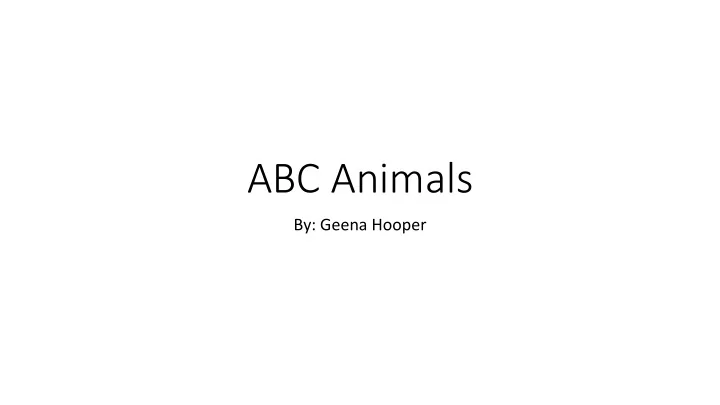

ABC Animals By: Geena Hooper
A is for……. Ant • Can Carry objects 50 times their own body weight • Mostly are black, brown, tan, or red
B is for …… BEAVER • Beavers front teeth are orange • Their tails are used for swimming, but they are also used as a prop to sit upright. Their tails can grow up to 15 inches long and 6 inches wide
C is for …… CHEETAH • Cheetahs are the fastest land animal, they can run 70 miles per hour • When running full speed, their stride is 6-7 meters
D is for ….. DOLPHIN • Dolphins are mammals • They have teeth, but they are not used to chew their food, but to catch their food. When a dolphin catches their prey they then swallow it whole.
E is for…….. EAGLES • Eagles have excellent eye sight • They are known to hunt foxes, wildcats, and even younger deer and goats.
F is for ……… FROG • There are around 5,000 different species of frogs • Frogs are able to jump 20 times their own body length
G is for ……. GIRAFFE • Giraffes are the tallest mammal on Earth • They spend most of their life standing up. They eat, sleep, and give birth all while standing up
H is for …..HAMSTER • Hamsters can store food in their cheeks and eat it later • They are actually born blind, but after two weeks of being alive they can open their eyes
I is for …… INSECT • Insects have three pairs of legs, which makes them have 6 legs all together • Most insects hatch from eggs
J is for …… JELLYFISH • Jellyfish eat small plants, fish eggs, and larvae (which is small fish) • They sting so they can catch their food
K is for …… KANGAROO • Kangaroos mainly eat grass and can survive long periods without water • Baby kangaroos (called joeys) stay with their mom until they are almost one year
L is for ……. LEMUR • Lemurs are very social and live in family groups • They are native from the island Madagascar
M is for …… MOOSE • Moose eat shrubs, woody plants, and aquatic vegetation • They use their antlers for fighting
N is for …… NEWT • Newts are carnivores, but they move slowly so they eat slow moving animals such as worms and snails. • Their legs are short and their tummies drag on the ground when the walk
O is for ……. OCTOPUS • Octopuses have three hearts. Two of them move blood beyond animal’s gills and one keeps circulation flowing for the organs • They have blue blood
P is for …….. PEACOCK • Peacocks cannot fly • The beautiful and colorful tails are characteristics only for males
Q is for…… QUAIL • Quails can survive around 3-5 years in the wild • They are able to fly short distances, but they quails spend most of their time on the ground
R is for ….. REINDEER • Reindeer are the only type of deer where the males and females both have antlers • They are the only mammal that grows new sets of antlers annually
S is for …… SHEEP • Sheep’s milk is ideal for making cheese • Because of their large rectangular eyes, they can almost see 360˚
T is for ……. TORTOISE • The tortoise shell is made up of 60 different bones all connected to each other • They eat grass, ferns, flowers, tree leaves, and fruit
U is for …….. UMBRELLA BIRD • Umbrella birds are found in South America and Central America rainforest • They are almost completely black with a chest on the top of their head that looks slightly like an umbrella
V is for …….. VULTURE • There are 23 species of vultures • They are able to eat 20% of their own body weight in one sitting
W is for …….. WALRUS • A walrus eats clams, mussels, and other organisms that are found on the bottom • They are social animals and congregate in large numbers
X is for ……. X -RAY TETRA • This is a fish that is found in coastal regions of the Amazon River in South America • It eats worms, insects, and small crustaceans
Y is for ……. YAK • Yaks eat grasses, lichens, and moss • They are covered with thick, wooly fur. The main purpose is to preserve the body heat and to protect against low outside temperatures
Z is for …….. ZEBRA • Zebras can run up to 65 miles per hour • Zebras are close to their mothers, but males also form strong bonds with their fathers
Recommend
More recommend